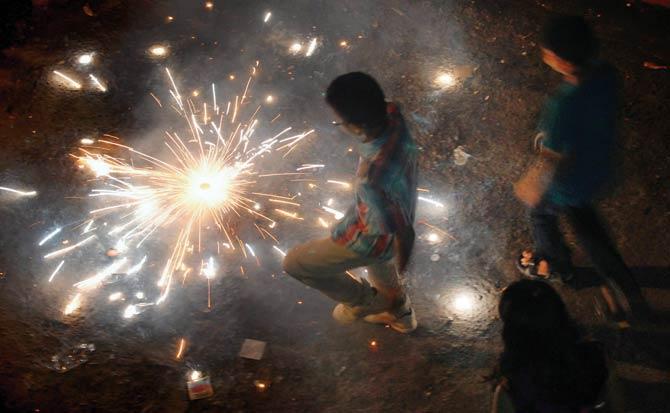Bursting of crackers in large quantities on Diwali night took the Air Quality Index (AQI) in Delhi and surrounding areas to a 'severe' level on Monday, figures recorded by air quality monitoring agencies showed


Representational pic
ADVERTISEMENT
New Delhi: Bursting of crackers in large quantities on Diwali night took the Air Quality Index (AQI) in Delhi and surrounding areas to a 'severe' level on Monday, figures recorded by air quality monitoring agencies showed. A thick layer of smog covered several parts of the National Capital Region (NCR) on Monday morning, which affected visibility as well.
Experts termed this year's pollution more hazardous owing to adverse factors, like slow wind speed and moisture in the air, which actually obstruct dispersion of suspended pollutants. On last Diwali night, the AQI was recorded at 343, while it has deteriorated this year, going up to 445, according to the data available with the Central Pollution Control Board (CPCB).
"According to the CPCB, AQI was 'very poor' last year. However, it is 'severe' this time. This year, pollutants are going to hang around close to the surface for more time due to slow wind and relatively more humidity, which will make air more toxic," said Vivek Chattopadhyay, Senior Researcher with the Centre for Science and Environment (CSE).
Interestingly, the level of Particulate Matter (PM) was lower this time compared to last Diwali. According to CPCB, the level of PM 2.5, a prominent pollutant, stood at an average of 431 micron per cubic metre (mpcm) compared to a safe level of 60 mpcm. In last Diwali, it was over 500 mpcm.
The PM 2.5 level means the particulate matters with a size of less than 2.5 microns that can reach the thinnest arteries of lungs in our body. The System of Air Quality and Weather Forecasting and Research (SAFAR) of the Ministry of Earth Sciences, had forcasted pollution at 'severe' level on October 30 and at 'worst' level on October 31.
Its data shows that PM 10, which are slightly bigger than the PM 2.5 and still very harmful for respiratory system, had touched 500 mpcm compared to a safe level of 100 mpcm since Sunday midnight. Last year, it had reached to 593 mpcm.
"Lower wind speeds and shallow inversion layer can lead to extremely high pollutant concentrations in winters. Regional scale multi-sectoral air quality management plan is required for NCR," said Sumit Sharma, Fellow, The Energy and Resources Institute (TERI).
The data revealed that air monitoring station at Anand Vihar, R.K. Puram, IHBAS, Shadipur, Mandir Marg and Punjabi Bagh (West Delhi) recorded pollution at critically high level. Pollution in Delhi peaks to severe level during Diwali as a hazardous mix of harmful gases and pollutants hang very close to the surface. The Delhi High Court had described the capital as "gas chamber" last year.
The pollution levels in neighbouring Agra in Uttar Pradesh and Gurgaon in Haryana were also alarming, as PM 2.5 level touched the figure of 494 mpcm and 500 mpcm, respectively, post Diwali. In the light of the rising level of pollution, Ministry of Environment, Forest and Climate Change on Monday reviewed the ambient air quality status of Delhi.
A release issued by the ministry said that open burning of solid waste, vehicular emissions, dust by the roadside and around construction sites in Delhi and stubble burning of crop residue in neighbouring States of Delhi were found to be the major contributors to pollution in Delhi.
The Central Pollution Control Board (CPCB) has decided to direct municipal local bodies in and around Delhi to take all possible steps to check burning of the solid waste in the open. Also, they will be asked to strictly enforce rules related to prevention of emissions from construction activities.
The CPCB will also direct Punjab, Haryana and other NCR States to effectively enforce ban on stubble burning in agriculture fields. The ministry has summoned the concerned secretaries of NCR states on November 4 to review the situation and discuss mitigation measures.
All agencies attached with public roads and Delhi Police will be asked to take measures to minimise pollution due to dust and vehicular emmissions.
 Subscribe today by clicking the link and stay updated with the latest news!" Click here!
Subscribe today by clicking the link and stay updated with the latest news!" Click here!






